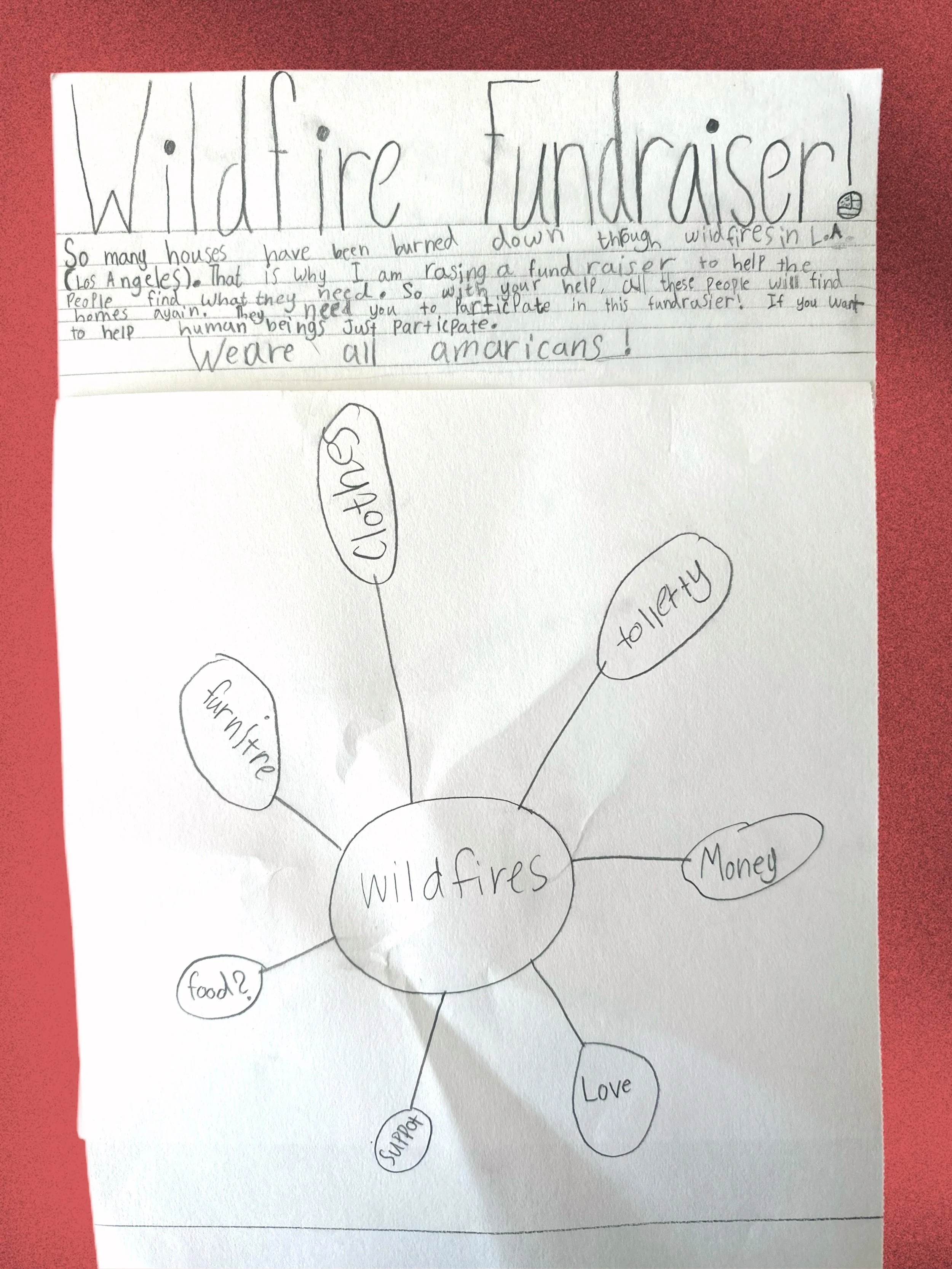
We have compiled resources to help families cope and find meaningful ways to give back to support people affected by the wildfires. #LAStrong.
Three Service Projects
Help out by running kid-friendly service projects to collect critical items to support people affected by the wildfires.
We are running TWO DRIVES and collecting CARE CARDS.
Stuff the Backpack Drive
🚨 We are collecting school supplies to benefit Project Hope and Dream Center.
Peanut Butter Challenge
🚨 We are collecting peanut butter for LA Food Bank.
Care Cards
🚨 We are collecting CARE CARDS for LA Fire Department.












Conversations & Feelings
Kids may be experiencing worry and feelings of overwhelm during times of disaster. Below are tips to support kids who may be feeling excessive levels of worry (anxiety) and sadness (grief).
Brainstorm with kids
Supporting children during natural disasters like the LA wildfires is crucial for their emotional well-being. Encouraging open discussions about their feelings and involving them in community aid can help them regain a sense of control. Dr. Tamar Kahane, a licensed clinical psychologist, emphasizes the importance of honesty and validation: "Start by acknowledging and validating their feelings and the reality. It is scary. It's not your job to pretend that everything is okay when it's not."(Source: ABC News)
Involving children in community support activities can also be beneficial. Save the Children suggests that engaging in volunteer work can give children a sense of control and security, promoting helpful behavior. They recommend including children in volunteer activities, as helping those in need can foster a positive outlook. (Source: Save the Children)
By fostering open communication and involving children in constructive actions, we can help them navigate the challenges posed by natural disasters and build resilience for the future.
Ireland, age 9, shows us her brainstorm of how to get involved and help others.
-

"Children often take emotional cues from their caregivers. By modeling calm and providing honest, age-appropriate information, parents can help kids feel safe and supported during natural disasters." – Dr. Robin Gurwitch, Clinical Psychologist and Professor at Duke University.
Managing Anxiety
"Using the word 'worry' instead of 'anxiety' can feel more relatable and less overwhelming for kids. It helps them express their emotions in a way that feels manageable and normalizes what they’re experiencing." – Dr. Mary Alvord, Clinical Psychologist and Author.
Hey, educators! Anxiety affects 25% of children aged 13-18 (CDC), making it one of the most common mental health challenges among students. When left unaddressed, anxiety can escalate into academic struggles, social withdrawal, and even physical symptoms.
Know the Signs
- Constantly seeking reassurance from teachers or peers.
- Avoiding new or challenging tasks out of fear of failure.
- Complaining of headaches, stomachaches, or difficulty concentrating.
Coping Tips
Character Education: Teach calming techniques, such as “box breathing” (inhale for 4 seconds, hold for 4, exhale for 4).
Service Learning: Involving children in community support activities can also be beneficial. Save the Children suggests that engaging in volunteer work can give children a sense of control and security, promoting helpful behavior. Facilitate a “Calm Corner Creation” project where students design a space for mindfulness activities in the classroom. Run the Peanut Butter Challenge, Stuff the Backpack Drive or CARE Cards Project.
Care Action: Practice “Share a Positive Thought” at the start of each day to set a calming tone.
Implementation Tips
With support, these students can develop emotional regulation and constructive coping skills. This role is a suggestion—always ensure emotional safety by:Providing reassurance without reinforcing dependency.
-

"Helping kids cope with sadness during a natural disaster starts with validating their feelings. Let them know it's okay to feel sad and encourage them to express their emotions through talking, drawing, or writing. Pair this with finding small, meaningful ways to help others, which can give them a sense of hope and purpose." – Dr. David Schonfeld, Pediatrician and Director of the National Center for School Crisis and Bereavement
Helping Kids Experiencing Sadness
Hey, educators! Persistent sadness can affect a student's motivation, relationships, and overall well-being. 1 in 7 children experiences depression before age 18 (NIMH). Creating a safe and supportive environment is key to helping students cope with difficult emotions.
Know the Signs
- Expressing hopelessness or a lack of interest in activities they once enjoyed.
- Isolating themselves from peers or avoiding social interactions.
- Displaying low energy or lack of focus during class.
Coping Tips
Character Education: Start each day with a “Gratitude Circle,” where students share one thing they’re thankful for.
Service Learning: Organize a “Care Notes Campaign,” encouraging students to write uplifting notes to peers. Kids can also do the CARE CARDS project and DIY Worry Relief Kits Project to work through difficult feelings.
Care Action: Add positive notes into a “Sunshine Jar.”
Implementation Tips
With support, these students can develop emotional regulation and constructive coping skills. This role is a suggestion—always ensure emotional safety by:Providing opportunities for students to share feelings in a safe, nonjudgmental space.
Rotating roles to help all students build empathy and understanding.
Reflecting on how gratitude and connection foster resilience and joy.




